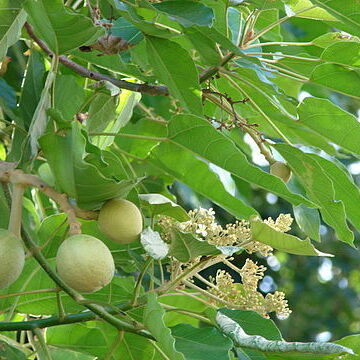Monoecious trees. Indumentum stellate. Leaves alternate, simple, entire or palmati-lobed, petiolate, stipulate, the stipules minute and fugacious. Inflorescences terminal, thyrsiform, androgynous, protogynous, with a solitary ♀ flower terminating each major axis, lateral cymules ♂; bracts subulate, readily caducous. Male flowers: calyx closed in bud, later valvately rupturing into 2–3 lobes; petals 5, free, imbricate; disc 5-lobed; stamens 4-verticillate, ± 20, the outer free, the inner ± united, borne on a conical receptacle, anthers introrse; pistillode 0. Female flowers: calyx, petals and disc as in the ♂ flowers; ovary 2–3-locular, with 1 ovule per locule; styles 2–3, thick, bilobed. Fruits large, drupaceous, indehiscent; exocarp fleshy; endocarp woody, 2–3-locular or 1-locular by abortion. Seeds ovoid, ecarunculate; testa thick, woody; albumen hard; embryo straight; cotyledons broad, flat.
Evergreen trees, monoecious; indumentum of stellate hairs. Leaves alternate; stipules minute, soon lost; petiole long, 2-glandular at apex; leaf blade simple, entire or 3-5-lobed, palmately 3-5-veined. Inflorescence terminal, branched, conical, lower bracts subtending clusters of male flowers, each major axis terminated by solitary female flower; buds subglobose. Male flowers: calyx splitting irregularly into 2 or 3(or 4) valvate lobes; petals 5, white or cream; disk glands 5, thick; stamens 15-32 in 3 or 4 series, outer ones free, inner ones united into column; anthers 2-locular, basi-to dorsibasifixed, introrse; pistillode absent. Female flowers similar to male but slightly larger, pedicellate; ovary 2(or 3)-locular; ovules 1 per locule; styles bifid. Fruit a drupe, subglobose; exocarp thinly fleshy; endocarp woody, 1-or 2-seeded. Seeds compressed globose, not carunculate.
Monoecious trees; sap milky. Lvs stipulate, alternate, entire or palmately lobed but not serrate. ♂ and ♀ fls mixed in terminal panicles; ♀ fls at ends of branches surrounded by several ♂. ♂ fls: calyx dividing into 2-3 segments, united in bud; petals 5; anthers 8-20; filaments sometimes branched. ♀ fls: calyx dividing into 2-3 segments; petals 5, much smaller than in ♂; ovary 2-5-celled, with 1 ovule in each cell; styles 2, deeply 2-fid. Fr. fleshy, spherical, with cells not separating at maturity.
Male flowers: calyx closed in bud, valvately rupturing into 2–3 lobes; petals 5, free, imbricate; disk glands 5, free, alternating with the petals; stamens c. 20, 4-verticillate, the outer free, the inner united into a column, anthers basifixed, introrse, longitudinally dehiscent; receptacle conical; pistillode absent.
Female flowers: calyx calyptrate, 2-lobed, splitting down one side; petals resembling those of the male flowers; disk shallowly 5-lobed; ovary 2-locular, with 1 ovule per loculus; styles 2, bipartite, erect.
Inflorescences terminal, thyrsiform, androgynous, protogynous, some cymules with terminal female flowers, others all male; bracts subulate, readily caducous.
Fruit usually 2-lobed, drupaceous, indehiscent; exocarp fleshy; endocarp thinly woody, 2-locular or 1-locular by abortion.
Seeds broadly ovoid, ecarunculate; testa thick, woody; albumen hard; embryo straight; cotyledons broad, flat.
Leaves alternate, stipulate, long-petiolate, simple, entire or palmately lobed, palminerved.
Stipules minute, fugacious.
Indumentum stellate.
Monoecious trees.


